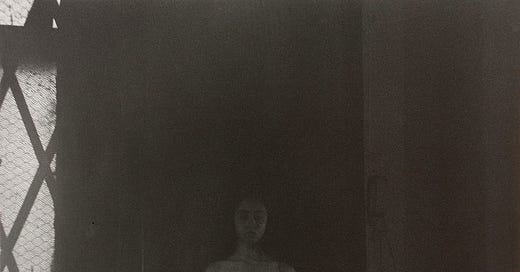Hi All,
I spent all of last week in a daze, feeling detached from reality listening to tried and true Radiohead and the podcast Aria Code. Both lovingly got me through the week with some energy to spare, and to get all my stuff done. Last week, I attended my first ever fashion shoot for the magazine I work at, saw some great plays, one with my friend Kristen and one by myself. Kristen and I saw Arthur Miller’s All My Sons at the Walterdale Theatre here in Edmonton and on Friday night I headed to Timms Centre For the Arts to watch Everybody, a play adapted from the 15th century man play Everyman and written by Branden Jacobs-Jenkins. I enjoyed both plays and was pleasantly surprised by their viscerality. I hardly read this week, but I started filing through some performance art pieces by the usual faves, Adrian Piper and Carolee Schneemann. I particularly enjoyed the works Food For The Spirit (1971) by Piper and Eye Body: 36 Transformative Actions (1963) by Schneemann. These works, as art always does, brought me back to myself in a way that made me want to stay. This week I’ll briefly discuss these works and why they act as a center for me in melancholic times. Hopefully they’ll bring y’all comfort and help you through the upcoming week should you find yourself stranded in the doldrums.
All my very best,
Your Sister Killjoy
02 | REFLECTIONS
In 1971 Adrian Piper holed herself up in her New York Apartment reading Immanuel Kant’s Critique of Pure Reason (1781) fasting, writing, and doing yoga. She became so immersed in Kant’s work on metaphysics that, by her account, she began to feel detached from her physical body. She captures this moment with periodical photographs of herself standing in front of a mirror while chanting excerpts of the text that made her question her material existence. The image included in this Substack is one of fourteen gelatin silver prints from her Kantian experiment. In it I can barely discern Piper’s features and can only just make out the outline of her naked body which stands upright and slim, her slender fingers holding onto the camera. On the left hand side, a brief glimpse of a window provides the only light source in this photograph.
The ghostliness of this image reminds me of two things: Carolee Schneemann’s Eye Body: 36 Transformative Actions (1963), performed some years before Piper’s Food For the Spirit, and Radiohead’s “How to Disappear Completely.” Both share a lot of emotional qualities with Piper’s Food for the Spirit in that they capture a dissociative melancholy that I find present in Piper’s work. Radiohead’s “How to Disappear Completely” is a five minute song that chronicles what I recognize as a depressive episode or maybe an anxiety attack or both. Floating along with simple lyrics like “I am not here/this isn’t happening” I fall back into myself and clutch at Piper’s performance. I notice the pale body of the telephone that hangs to Piper’s left, my right. I find myself wondering if when she began to dissociate she called up a friend to sound a voice that would bring her back or if she solely relied on her chanting to keep her grounded. I wonder if she broke her fasts by calling in food from restaurants around the corner. All this and more keeps me enamoured with Food for the Spirit.
Eye Body: 36 Transformative Actions was performed by performance art G.O.A.T Carolee Schneemann in 1963. According to Schneemann, the aim of the piece was to have her “ actual body to be combined with the work as an integral material— a further dimension of the construction... [in which] I am both image maker and image. The body may remain erotic, sexual, desired, desiring, but it is as well votive: marked, written over in a text of stroke and gesture discovered by my creative female will.''1 This is where I find that the two works overlap, the use of the body, in particular the female body, to transform reality and feeling. In Piper’s case a metaphysical transformation is made by manipulating/regimenting her body and mind through exercise, fasting, and reading. Schneemann’s transformative acts were also based on ritualizing her process so that it could put her in a trancelike state, which would heighten the submission of herself into materials that she was working with.
I think of one of Schneemann’s images from Eye Body: 36 Transformative Actions in which she is holding a broken mirror up to her face as she looks at herself or photographs herself in a mirror. The capturing of this image to me is a bit of an enigma, although if I give it enough thought I will be sure to figure it out. Except I don’t have room for thought beyond this moment. This image in its fragmented mimicry of dissociation for me reminds me of those pale moments in Piper’s apartment in which she documents herself periodically as she loses ground. I think of the many women that exist in both performances and how the whole body is sacrificed as a transformative act of living beyond oneself.
https://www.schneemannfoundation.org/artworks/eye-body-36-transformative-actions-for-camera/6





